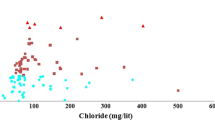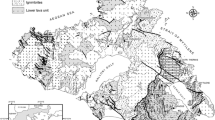Abstract
The composition of Spanish natural mineral waters has been determined by means of inductively coupled plasma-mass spectrometry, inductively coupled plasma-atomic emission spectrometry, ionic chromatography and other routine techniques. Methods were applied to samples of bottled water from springs situated in five different mountain systems such as Cordillera Costero-Catalana, Macizo Galaico, Sistemas Béticos, Sistema Central and Sistema Ibérico. Pattern recognition techniques have been applied to differentiate the origin of samples. Data were initially studied by using nonparametric multiple comparison techniques and principal component analysis to highlight data trends. Classification models based on linear discriminant analysis and multilayer perceptron artificial neural networks have been built and validated by means of a stratified jackknifing methodology. An iterative approach has been used to build an artificial neural network model based on the variables selected by linear discriminant analysis. The prediction ability of the constructed model was 94 %.




Similar content being viewed by others
References
European Union (2009) Directive 2009/54/EC of the European Parliament and of the Council of 18 June 2009 on the exploitation and marketing of natural mineral waters. Official Journal of the European Union, L 164/45, Brussels. http://eur-lex.europa.eu/eli/dir/2009/54/oj. Accessed 9 July 2016
Sipos L, Kovács Z, Sági-Kiss V, Csiki T, Kókai Z, Fekete A, Éberger K (2012) Discrimination of mineral waters by electronic tongue, sensory evaluation and chemical analysis. Food Chem 135:2947–2953. doi:10.1016/j.foodchem.2012.06.021
Oyebog SA, Ako AA, Nkeng GE, Suh EC (2012) Hydrogeochemical characteristics of some Cameroon bottled waters, investigated by multivariate statistical analyses. J Geochem Explor 112:118–130. doi:10.1016/j.gexplo.2011.08.003
Peh Z, Ŝorŝa A, Halamić J (2010) Composition and variation of major and trace elements in Croatian bottled waters. J Geochem Explor 107:227–237. doi:10.1016/j.gexplo.2010.02.002
Fugedi U, Kuti L, Jordan G, Kerek B (2010) Investigation on the hydrogeochemistry of some bottled mineral waters in Hungary. J Geochem Explor 107:305–316. doi:10.1016/j.gexplo.2010.10.011
Naddeo V, Zarra T, Belgiorno V (2008) A comparative approach to the variation of natural elements in Italian bottled waters according to the national and international standard limits. J Food Comp Anal 21:505–514. doi:10.1016/j.jfca.2008.02.010
Birke M, Rauch U, Harazim B, Lorenz H, Glatte W (2010) Major and trace elements in German bottled water, their regional distribution and accordance with national and international standards. J Geochem Explor 107:245–271. doi:10.1016/j.gexplo.2010.06.002
Güler C (2007) Characterization of Turkish bottled waters using pattern recognition methods. Chemom Intell Lab Syst 86:86–94. doi:10.1016/j.chemolab.2006.08.009
Gutiérrez-Reguera F, Seijo-Delgado I, Montoya-Mayor R, Ternero-Rodríguez M (2012) Caracterización fisicoquímica (parámetros generales y componentes mayoritarios) de las aguas minerales naturales envasadas de España. Afinidad 519:165–174
Smedley PL (2010) A survey of the inorganic chemistry of bottled mineral waters from the British Isles. Appl Geochem 25:1872–1888. doi:10.1016/j.apgeochem.2010.10.003
Souza AL, Lemos SG, Naozuka J, Miranda-Correia PR, Oliveira PV (2011) Exploring the emission intensities of ICPOES aided by chemometrics in the geographical discrimination of mineral waters. J Anal At Spectrom 26:852–860. doi:10.1039/C0JA00071J
Groŝelj N, van der Veer G, Tuŝar M, Vračko M, Novič M (2010) Verification of the geological origin of bottled mineral waters using artificial neural networks. Food Chem 118:941–947. doi:10.1016/j.foodchem.2008.11.085
Thermo Electron Corporation (2004) X series ICP-MS getting started guide. Ref. no. S419MA. Thermo Electron Corporation, Winsford
AOAC (2012) Appendix F: guidelines for standard method performance requirements. In: Official methods of analysis of AOAC international, 19th edn. AOAC International, Gaithersburg
Cuadros L, García AM, Bosque JM (1996) Statistical estimation of linear calibration range. Anal Lett 29:1231–1239. doi:10.1080/00032719608001471
ISO (1994) ISO 9963-1:1994 Water quality. Determination of alkalinity. Part 1: determination of total and composite alkalinity. International Organization for Standardization, Geneva
ISO (1985) ISO 7888:1985 Water quality. Determination of electrical conductivity. International Organization for Standardization, Geneva
Muth JE (1999) Basic statistic and pharmaceutical statistical applications, 1st edn. Chapman and Hall/CRC, New York
Jolliffe IT (2002) Principal components analysis, 2nd edn. Springer, New York
Palacios-Morillo A, Alcázar A, Pablos F, Jurado JM (2013) Differentiation of tea varieties using UV–Vis spectra and pattern recognition techniques. Spectrochim Acta A 103:79–83. doi:10.1016/j.saa.2012.10.052
Tsakovski S, Simeonov V (2009) Chemometrics as a tool for treatment processing of multiparametric analytical data sets. In: Namiesnik J, Szefer P (eds) Analytical measurements in aquatic environments. CRC Press, Boca Raton, pp 369–388
Valle S, Li W, Qin SJ (1999) Selection of the number of principal components: the variance of reconstruction error criterion with comparison to other methods. Ind Eng Chem Res 38:4389–4401. doi:10.1021/ie990110i
Massart DL (1998) Handbook of chemometrics and qualimetrics, part B. Elsevier, Amsterdam
Forina M, Armanino C, Leardi R, Drava G (1991) A class modelling technique based on potential functions. J Chemom 5:435–453. doi:10.1002/cem.1180050504
Kott PS (2001) The delete-a-group jackknife. J Off Stat 17:521–526
Tetko IV, Livingstone DJ, Luik AI (1995) Neural network studies. 1. Comparison of overfitting and overtraining. J Chem Inform Comput Sci 35:826–833. doi:10.1021/ci00027a006
Martin AE, Watling RJ, Lee GS (2012) The multi-element determination and regional discrimination of Australian wines. Food Chem 133:1081–1089. doi:10.1016/j.foodchem.2012.02.013
Author information
Authors and Affiliations
Corresponding author
Electronic supplementary material
Below is the link to the electronic supplementary material.
Rights and permissions
About this article
Cite this article
Gutiérrez-Reguera, F., Jurado, J., Montoya-Mayor, R. et al. Geographical classification of Spanish bottled mineral waters by means of iterative models based on linear discriminant analysis and artificial neural networks. Neural Comput & Applic 29, 459–468 (2018). https://doi.org/10.1007/s00521-016-2459-5
Received:
Accepted:
Published:
Issue Date:
DOI: https://doi.org/10.1007/s00521-016-2459-5




